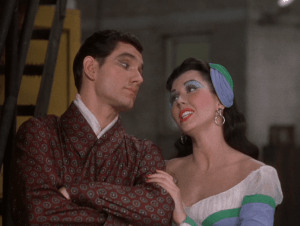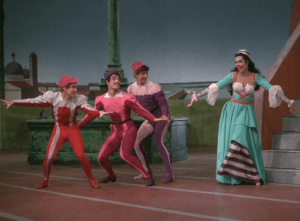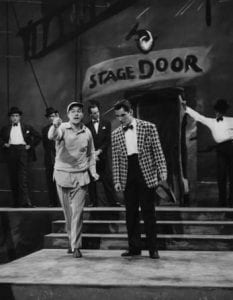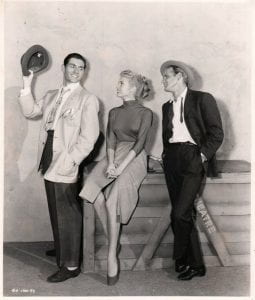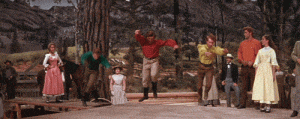
Tommy Rall was a man who defied gravity. Whether executing impossibly fast twirls, nimbly leaping through the air, or doing a series of stunningly intricate tap steps, Rall proved to be one of the best dancers Hollywood would ever see. And yet he never became the star he deserved to be.
On October 6, at the age of 90, Rall died of congestive heart failure while recovering from heart surgery. An irreplaceable talent from the Golden Age of Hollywood, I’ve been in love with his work ever since he took my breath away in Kiss Me, Kate many years ago. Although his filmography is small, the impact of Rall’s dancing is so momentous that I was frustrated to discover that, as I’m typing this, no obituaries have yet been written for him. This really didn’t sit right with me, so I wanted to offer my own tribute to the man whose artistry has never failed to make me giggle with delight. (Yes, giggle.)
Born with a crossed eye, Rall’s mother realized her four-year-old son would have difficulty with reading and enrolled him in dance classes to help him compensate. After receiving corrective surgery, though, Rall’s love for dancing encouraged him to continue lessons and he soon was performing in vaudeville and small theaters. This led to the Jivin’ Jacks ’n’ Jills, an ensemble that also included Donald O’Connor and performed in seven little-known musicals for Universal Pictures. At fourteen, he turned to ballet for three years before finding success on Broadway, where he worked with such venerable names as Irving Berlin, Jerome Robbins, Gower Champion, Moss Hart, and George Abbott.
With a background in ballet, acrobatics, “hep-cat” styles like jitterbug and tap, and musical theatre, Rall was a force to be reckoned with by the time he returned to the silver screen in 1953 for Kiss Me, Kate, a brilliant Cole Porter musical that features the impeccable dancing of Rall, Bobby Van, Ann Miller, and Bob Fosse. I cannot emphasize enough how mind-blowing their work is here, but amidst all of this legendary talent, it’s Rall who catches my eye the most. Swaggering through the film with smirking one-liners and dizzying athleticism, his presence is utterly bewitching and, well, cool.
The exquisite precision of Rall’s movement collided with a tough, street-hardened persona to create this unique blend of dangerous elegance that no other dancer had in Hollywood. You can see this in the other spectacular musicals he made in the ’50s. Seven Brides for Seven Brothers, of course, has the famous barn dance, choreographer Michael Kidd’s innovative triumph that continues to wow audiences over 60 years later. My Sister Eileen, meanwhile, had Rall playing a wolfish reporter, the foil to Bob Fosse’s sweet drugstore soda jerk. The tension between their characters is illustrated in the “Alley Dance” number, or, as I like to call it, “the reason celluloid exists.” To see these two titans square off against one another is extraordinary and joyous in so many ways.
Conceived and directed by Gene Kelly, Invitation to the Dance saw Rall collaborating with another musical icon, although they don’t share the screen, sadly. A fascinating anthology film that is told through pantomime and dance, Rall has an energetic yet self-contained solo as The Sharpie in the “Ring Around the Rosy” sequence. One of the most phenomenal things about Rall is illustrated here: if you didn’t hear his taps, you’d swear his feet never touched the ground. “The best all-around dancer we had over at MGM was Tommy Rall,” Gene Kelly told his widow, Patricia Ward Kelly. “He could do anything and do it better than any other dancer.”
In 1959, Rall returned to the stage and would only do the sporadic film, such as Merry Andrew with Danny Kaye, an uncredited part opposite Barbra Streisand in Funny Girl, and Pennies from Heaven, which has Rall doing a wonderfully goofy tap routine with Steve Martin and Robert Fitch. Funny, graceful, and ultimately incomparable, Tommy Rall will always be someone I wish was better known. He epitomized the effervescence and magic of dance with a skill and a beauty that only the truly gifted have. It would be easy to feel mournful over his passing, but I also feel thankful — thankful that such an astonishing performer existed and that he shared his light with us for many, many years.

Michaela Owens is thrilled to be the editor of A Place for Film, in addition to being IU Cinema’s Publications Editor. An IU graduate with a BA in Communication and Culture and an MA in Cinema and Media Studies, she has also been a volunteer usher at IU Cinema since 2016. She never stops thinking about classic Hollywood, thanks to her mother’s introduction to it, and she likes to believe she is an expert on Katharine Hepburn and Esther Williams.
